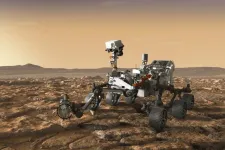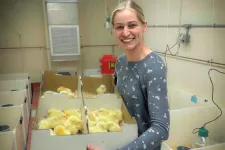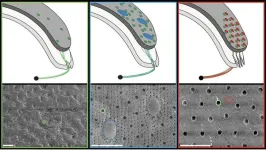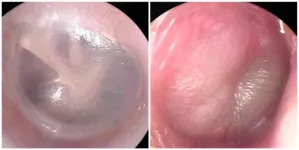(Press-News.org) FOR IMMEDIATE RELEASE
People with cancer have different amounts of a type of repetitive DNA — called Alu elements — than people without cancer. Now, machine learning can measure that from a blood draw. Researchers at the Johns Hopkins Kimmel Cancer Center have used this finding to improve a test that detects cancer early, validating and reproducing the results by starting with a sample size tenfold larger than typical of such types of studies.
The research was published Jan. 24 in the journal Science Translational Medicine.
Alu elements are small: around 300 base pairs long out of 2 billion steps in a DNA ladder. But, changes in the proportion of Alu elements in people’s blood plasma occur regardless of where cancer originates, explains lead study author Christopher Douville, Ph.D., an assistant professor of oncology at Johns Hopkins.
“Blood testing holds great promise for the earlier detection of cancers before people exhibit any symptoms,” Douville says. “However, analyzing results with machine learning “has not necessarily translated into long-term success for patients when minor fluctuations produce widely different predictions in these complex models. To have a long-term impact on patient care, physicians and patients must have confidence that models consistently and reproducibly classify cancer status. In our manuscript, we evaluated 1,686 individuals multiple times to assess whether our machine learning model consistently delivers the same answer.”
Douville and colleagues developed a test to detect aneuploidy, chromosome copy number alterations found in cancers. The test measured aneuploidy through a blood test called liquid biopsy, which detects fragments of cancer cell DNA circulating in the bloodstream.
However, Douville observed an unexplained signal that distinguished cancer from noncancer but could not be explained by chromosomes being gained or lost.
The team decided to combine their previous test — able to check 350,000 repetitive locations in DNA — with an unbiased machine learning approach.
Douville and colleagues collected samples from 3,105 people with solid cancers and 2,073 without. The study covered 11 cancer types and 7,615 blood samples. The repeats were used as replicates to see how well the model worked. They reached 98.9% specificity, which meant they could minimize false-positive test results. “This is crucial when screening asymptomatic patients, so people aren’t told incorrectly that they have cancer,” says Douville.
In an independent validation cohort, adding Alu elements to the machine learning model caught 41% of cancer cases missed by eight existing biomarkers and the group’s previous test, making “a greater contribution,” authors wrote in the paper, “than aneuploidy or proteins.” The type of repetitive DNA contributing most to cancer detection was the largest subfamily of Alu elements, called AluS; the blood plasma of people with cancer had less of it than usual.
The model was called A-PLUS (Alu Profile Learning Using Sequencing). The code is available online.
Despite making up 11% of DNA from humans and other primates, Alu elements have been long touted as too difficult to use as a biomarker, Douville says. “They are small and repetitive — technically difficult. But this research shows that counting repetitive lengths of DNA in blood plasma — a motley crew of DNA fragments hailing from organs throughout the body — is cost-effective and enhances early cancer detection,” Douville says. They envision their Alu-based cancer detection as a complement to the toolkit of other cancer tests available to clinicians. The next step is prioritizing which biomarkers seem the most promising and aggregating them together.
Study co-authors included Kamel Lahouel, Albert Kuo, Haley Grant, Bracha Erlanger Avigdor, Samuel D. Curtis, Mahmoud Summers, Joshua D. Cohen, Yuxuan Wang, Austin Mattox, Jonathan Dudley, Lisa Dobbyn, Maria Popoli, Janine Ptak, Nadine Nehme, Natalie Silliman, Cherie Blair, Katharine Romans, Christopher Thoburn, Jennifer Gizzi, Michael Goggins, Ie-Ming Shih, Anne Marie Lennon, Ralph H. Hruban, Chetan Bettegowda, Kenneth W. Kinzler, Nickolas Papadopoulos, Bert Vogelstein and Cristian Tomasetti of the Johns Hopkins University School of Medicine and City of Hope.
Additional authors were from the Department of Medicine and Department of Epidemiology at the University of Pittsburgh; the Department of Surgery at NYU Langone; and abroad in Vietnam (Pham Ngoc Thach University of Medicine and Saigon Precision Medicine Research Center) and Australia (the Walter and Eliza Hall Institute of Medical Research, the University of Melbourne, the University of Technology Sydney and the University of New South Wales).
This study was supported by the NIH (grants U01CA271884, R21NS113016, RA37CA230400, U01CA230691, 5P50CA062924-22, Ovarian Cancer SPORE DRP 80057309), Oncology Core CA 06973, the Virginia and D.K. Ludwig Fund for Cancer Research, the John Templeton Foundation (62818), the Commonwealth Fund, the Thomas M. Hohman Memorial Cancer Research Fund, Alex’s Lemonade Stand Foundation, The Sol Goldman Sequencing Facility at Johns Hopkins, the Conrad R. Hilton Foundation, the Benjamin Baker Endowment (80049589), Swim Across America, Burroughs Wellcome Career Award for Medical Scientists, the Thomas M. Hohman Memorial Cancer Research Fund, and the NHMRC (Investigator Grant APP1194970).
Under a license agreement between Exact Sciences Corp. and The Johns Hopkins University, Tomasetti and the university are entitled to royalty distributions. Tomasetti has patent applications for I.P. related to cancer early detection, is a member of the scientific advisory board of PrognomiQ Inc., an adviser for Haystack Oncology, and a paid consultant for the Rising Tide Foundation and Bayer AG. Vogelstein, Kinzler and Papadopoulos are founders of Thrive Earlier Detection, an Exact Sciences Company, and hold equity in and are consultants to CAGE Pharma. Kinzler, Papadopoulos and Douville are consultants to Thrive Earlier Detection. Vogelstein, Kinzler, Papadopoulos and Douville hold equity in Exact Sciences. Papadopoulos and Douville are consultants to Thrive Earlier Detection. Vogelstein, Kinzler, Cohen and Papadopoulos are founders of and own equity in Haystack Oncology and ManaT Bio. Kinzler and Papadopoulos are consultants to Neophore. Vogelstein is a consultant to and holds equity in Catalio Capital Management. Bettegowda is a consultant to Depuy-Synthes, Bionaut Labs, Haystack Oncology and Galectin Therapeutics, and is a co-founder of OrisDx. Bettegowda and Douville are co-founders of Belay Diagnostics.
The companies named above, as well as other companies, have licensed previously described technologies related to the work described in this paper from The Johns Hopkins University. Vogelstein, Kinzler, Papadopoulos, Bettegowda and Douville are inventors of some of these technologies. Licenses to these technologies are or will be associated with equity or royalty payments to the inventors as well as to The Johns Hopkins University. Patent applications on the work described in this paper may be filed by The Johns Hopkins University. The terms of these arrangements are managed by The Johns Hopkins University in accordance with its conflict-of-interest policies.
END
Small and overlooked: Amount of repetitive DNA in blood hints at cancer early
2024-03-04
ELSE PRESS RELEASES FROM THIS DATE:
Study determines the original orientations of rocks drilled on Mars
2024-03-04
As it trundles around an ancient lakebed on Mars, NASA’s Perseverance rover is assembling a one-of-a-kind rock collection. The car-sized explorer is methodically drilling into the Red Planet’s surface and pulling out cores of bedrock that it’s storing in sturdy titanium tubes. Scientists hope to one day return the tubes to Earth and analyze their contents for traces of embedded microbial life.
Since it touched down on the surface of Mars in 2021, the rover has filled 20 of its 43 tubes with cores of bedrock. Now, MIT geologists have remotely determined a crucial property of the rocks collected to date, which will help scientists answer key questions about the planet’s ...
Illinois study: Supporting disease-challenged broiler chickens through nutrition
2024-03-04
URBANA, Ill. — When broiler chickens are busy fighting the parasitic infection coccidiosis, they can’t absorb nutrients efficiently or put energy toward growth. With consumer sentiment pitted against antimicrobials and other drugs, producers still have some options to ensure optimal growth during inevitable outbreaks. New research from the University of Illinois Urbana-Champaign suggests diet changes might help.
“Vaccines and anticoccidials are the traditional ways to prevent this disease. Nutrition can't replace all of the pharmaceuticals, but it can be supportive in providing care,” said senior study author Ryan Dilger, ...
Communities severed by roads and traffic experience a larger number of collisions in New York City
2024-03-04
March 4, 2024- New York City neighborhoods with disrupted community connections, due to traffic, roads, and transport infrastructure, are experiencing an increase in traffic collisions. This increase is seen both in total collisions and for those in which pedestrians or cyclists are injured or killed, according to a new study from Columbia University Mailman School of Public Health. The findings are reported in the journal Environment International.
“Despite recent remarkable progress, road safety remains an urgent urban issue in New York and other U.S. cities. It is important to understand how the spatial configuration of the city enhances ...
Study shows new class of antivirals that works against SARS-CoV-2
2024-03-04
EDMONTON — A University of Alberta research team has uncovered a new class of drugs with the potential to prevent or treat infections in a future viral outbreak.
In the paper, published this week in Nature, the team reports that SARS-CoV-2 — the virus that causes COVID-19 — activates a pathway in cells that stops the production of peroxisomes and interferon, key parts of the normal immune response. The team successfully tested a new class of antiviral drugs that stimulate interferon production to reverse that effect.
Tom ...
Cost of direct air carbon capture to remain higher than hoped
2024-03-04
Switzerland plans to reduce its net carbon emissions to zero by no later than 2050. To achieve this, it will need to drastically reduce its greenhouse gas emissions. In its climate strategy, the Swiss government acknowledges that some of these emissions, particularly in agriculture and industry, are difficult or impossible to avoid. Swiss climate policy therefore envisages actively removing 5 million tonnes of CO2 from the air and permanently storing it underground. By way of comparison, the Intergovernmental ...
Unraveling the mystery of chiton visual systems
2024-03-04
(Santa Barbara, Calif.) — You’d probably walk past a chiton without even seeing it. These creatures often look like nothing more than another speck of seaweed on the crusty intertidal rocks. But it sees you. At least, if it’s one of the species with eyes dotting its platemail shell.
A team of scientists — led by Rebecca Varney at UC Santa Barbara’s Department of Ecology, Evolution, and Marine Biology (EEMB) — discovered that some of these tough mollusks sport the most recently evolved eyes with a lens. What’s more, the ...
Case Western Reserve University-led research team discovers new method to test for oral cancer
2024-03-04
CLEVELAND—Oral cancers and precancerous mouth lesions are considered especially difficult to diagnose early and accurately.
For one, biopsies are expensive, invasive, stressful for the patient and can lead to complications. They’re also not feasible if repeated screenings of the same lesion are required.
But a team of researchers, led by a clinician scientist at the Case Western Reserve University School of Dental Medicine, has discovered a noninvasive, low-cost test to detect oral cancer, monitor precancerous lesions and determine when a biopsy is warranted.
Their findings, published ...
Firearm access and gun violence exposure are common in Black and native communities
2024-03-04
A New Jersey Gun Violence Research Center study is the first to provide nationally representative data on gun use, storage and violence within Black and American Indian/Alaskan Native (AIAN) families.
Both Black and native communities have seen increasingly elevated rates of gun violence victimization, including homicide and suicide, according to the Centers for Disease Control and Prevention. In recent years, minorities have become more represented among new firearm owners. Despite this, research on firearm access, storage and use has focused on samples of white adults. This prevents understanding the access Black and native individuals have to firearms, whether they are stored ...
New AI smartphone tool accurately diagnoses ear infections
2024-03-04
A new cellphone app developed by physician-scientists at UPMC and the University of Pittsburgh, which uses artificial intelligence (AI) to accurately diagnose ear infections, or acute otitis media (AOM), could help decrease unnecessary antibiotic use in young children, according to new research published today in JAMA Pediatrics.
AOM is one of the most common childhood infections for which antibiotics are prescribed but can be difficult to discern from other ear conditions without intensive training. The new AI tool, which makes a diagnosis by assessing ...
Screen time and parent-child talk when children are ages 12 to 36 months
2024-03-04
About The Study: This study found a negative association between screen time and measures of parent-child talk when children are 12 to 36 months of age. For every additional minute of screen time, children heard fewer adult words, spoke fewer vocalizations, and engaged in fewer back-and-forth interactions. Interventions aiming to promote early use of language should include support to manage screen time.
Authors: Mary E. Brushe, Ph.D., of the University of Western Australia in Adelaide, South Australia, Australia, is the corresponding author.
To access the embargoed study: Visit our For The Media website at this link https://media.jamanetwork.com/
(doi:10.1001/jamapediatrics.2023.6790)
Editor’s ...





